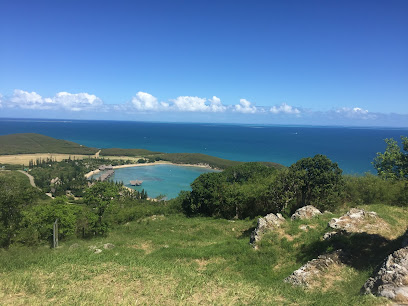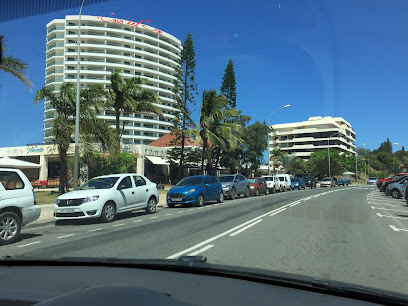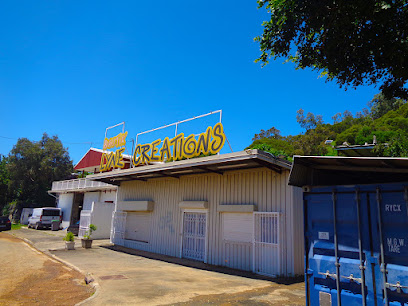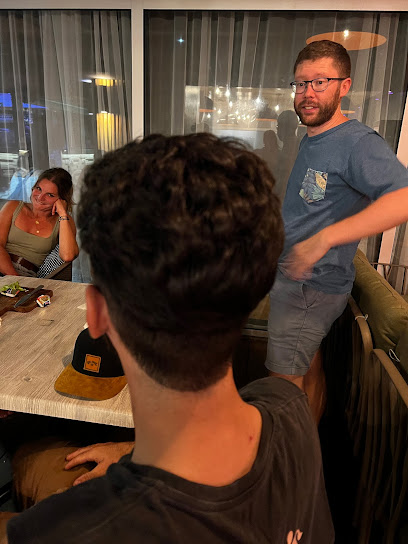
Ile des Pins: The Jewel of the Pacific
Discover Ile des Pins, the Jewel of the Pacific, where turquoise waters, white sandy beaches, and lush pine forests create a paradise for relaxation and adventure.
Ile des Pins, often referred to as the 'Isle of Pines,' is a small but stunning island located in New Caledonia. Known for its turquoise waters, pristine white sandy beaches, and lush pine forests, it is a paradise for those seeking tranquility and natural beauty. The island is a perfect blend of French and Melanesian cultures, offering a unique experience for visitors. The friendly locals and laid-back atmosphere make it an ideal spot for relaxation. The island's striking natural features include the famous Oro Bay, where you can swim in a natural pool surrounded by towering pine trees and coral reefs. The island is also home to numerous caves, such as the Queen Hortense's Cave, which is steeped in local legends. For the more adventurous, there are opportunities for snorkeling, diving, and exploring the island's rich marine life. History enthusiasts will find the island's past intriguing, with remnants of its time as a French penal colony still visible. The local Kanak culture is also a highlight, with traditional dances and crafts offering a glimpse into their way of life. Whether you're lounging on the beach, exploring the island's natural wonders, or immersing yourself in its rich culture, Ile des Pins promises an unforgettable experience.
Local tips in Ile des Pins
- Visit Oro Bay during low tide to fully enjoy the natural pool.
- Bring cash, as ATMs are scarce and many places do not accept credit cards.
- Respect local customs and ask for permission before photographing people.
- Rent a bike or scooter to explore the island at your own pace.
- Try the local specialty, bougna, a traditional Melanesian dish cooked in banana leaves.
Ile des Pins: The Jewel of the Pacific
Ile des Pins, often referred to as the 'Isle of Pines,' is a small but stunning island located in New Caledonia. Known for its turquoise waters, pristine white sandy beaches, and lush pine forests, it is a paradise for those seeking tranquility and natural beauty. The island is a perfect blend of French and Melanesian cultures, offering a unique experience for visitors. The friendly locals and laid-back atmosphere make it an ideal spot for relaxation. The island's striking natural features include the famous Oro Bay, where you can swim in a natural pool surrounded by towering pine trees and coral reefs. The island is also home to numerous caves, such as the Queen Hortense's Cave, which is steeped in local legends. For the more adventurous, there are opportunities for snorkeling, diving, and exploring the island's rich marine life. History enthusiasts will find the island's past intriguing, with remnants of its time as a French penal colony still visible. The local Kanak culture is also a highlight, with traditional dances and crafts offering a glimpse into their way of life. Whether you're lounging on the beach, exploring the island's natural wonders, or immersing yourself in its rich culture, Ile des Pins promises an unforgettable experience.
When is the best time to go to Ile des Pins?
Iconic landmarks you can’t miss
Natural pool
Experience the serene beauty of the Natural Pool in New Caledonia, a tropical paradise perfect for relaxation and adventure enthusiasts alike.

Amédée Lighthouse
Discover the stunning Amédée Lighthouse, a historical maritime gem surrounded by turquoise waters and vibrant coral reefs in New Caledonia.

Le Méridien Ile des Pins
Experience luxury and tranquility at Le Méridien Ile des Pins, where pristine beaches and vibrant culture await in New Caledonia.

Parc Zoologique Et Forestier Michel Corbasson
Experience New Caledonia's unique biodiversity at Parc Zoologique Et Forestier Michel Corbasson - a haven of wildlife and lush landscapes.

OURE TERA beach resort
Experience the serene beauty of Oure Tera Beach Resort, where luxury meets adventure in the heart of New Caledonia's tropical paradise.

Isle of Pines
Discover the enchanting Isle of Pines, a tropical paradise in New Caledonia, offering pristine beaches, lush landscapes, and vibrant culture.

Blue River Provincial Park
Explore the breathtaking Blue River Provincial Park in New Caledonia, a stunning national park featuring lush landscapes, diverse wildlife, and endless outdoor adventures.

Hotel Kou-Bugny
Experience the beauty of Kuto, New Caledonia at Hotel Kou-Bugny, your ideal retreat for comfort, adventure, and local cuisine.

La Madeleine Waterfalls
Discover the natural beauty and historical significance of La Madeleine Waterfalls in Yate, New Caledonia, a must-visit destination for every traveler.

MANA NAUTIQUE - Excursions Île des Pins
Explore the stunning waters of Île des Pins with MANA NAUTIQUE, your gateway to unforgettable boat tours and marine adventures in New Caledonia.

Relais Le Kuberka
Discover the exquisite flavors of New Caledonia at Relais Le Kuberka, where local ingredients meet international culinary creativity in a stunning waterfront setting.

Grotte de la Reine Hortense
Explore the natural beauty and unique wildlife of Grotte de la Reine Hortense, a captivating wildlife park in New Caledonia.

Hotel Kodjeue
Discover serenity and natural beauty at Hotel Kodjeue in New Caledonia, your perfect getaway for relaxation and cultural exploration.

Kunie Scuba Center (Diving Center)
Experience the vibrant underwater world of New Caledonia at Kunie Scuba Center - your gateway to unforgettable diving adventures.

Gite Nataiwatch
Discover the authentic taste of New Caledonia at Gite Nataiwatch, a charming restaurant in Kuto offering local delicacies and stunning views.

Unmissable attractions to see
Natural pool
Experience the natural beauty and serenity of the stunning Natural Pool in Yuate Tremwatre, a hidden gem in New Caledonia perfect for relaxation.

Fort Teremba
Explore Fort Teremba, a historical landmark in New Caledonia, where heritage meets breathtaking coastal beauty.

Grotte de la Reine Hortense
Explore Grotte de la Reine Hortense, a breathtaking cave system and wildlife haven in New Caledonia, where nature's beauty and culture intertwine.

Saint Maurice
Explore Saint Maurice in Vao, New Caledonia - a serene tourist attraction blending stunning nature with rich cultural experiences.

Canons de Nouville
Discover the breathtaking beauty and rich history of Canons de Nouville, a must-visit tourist attraction in Nouméa, New Caledonia.

Aquarium Naturel
Explore the natural beauty of Aquarium Naturel in Tadine, New Caledonia, where vibrant marine life meets crystal-clear waters in a stunning tropical paradise.

L'Oasis
Discover the serene beauty of L'Oasis in Prony, New Caledonia, a hidden gem perfect for relaxation and adventure seekers alike.

NEUTOMO EXCURSION ILE DES PINS
Experience the stunning landscapes and vibrant marine life of Ile des Pins with Neutomo Excursion, the premier boat tour agency in New Caledonia.

LYVAI TOURS
Experience the beauty and culture of New Caledonia with guided tours at LYVAI TOURS, a top tourist attraction in Nouméa.

Accès au cap N'Dua
Experience breathtaking views of nature at Cap N'Dua Observation Deck in New Caledonia, a hidden gem for nature lovers and photographers.

Baie d’Upi Chemin Baie d’Oro
Explore the enchanting Baie d’Upi Chemin Baie d’Oro, where pristine beaches meet vibrant marine life in a picturesque New Caledonian paradise.

Grotte de la troisième
Explore the stunning Grotte de la Troisième in Kuto, New Caledonia, a breathtaking natural wonder filled with unique rock formations and rich history.

Trou bleu Yaté
Explore Trou Bleu Yaté, a breathtaking hiking area in New Caledonia featuring stunning landscapes, vibrant flora, and serene water views.

Rivière de sable d'Oro
Experience the breathtaking beauty of Rivières de Sable d'Oro, a serene natural attraction in New Caledonia's Yuate Tremwatre region, perfect for relaxation and adventure.

Caledonia Birds - Guide expert en ornithologie - Birding in New Caledonia
Experience the rich biodiversity and stunning avian life at Caledonia Birds, the ultimate bird watching destination in New Caledonia.

Essential places to dine
Le Méridien Ile des Pins
Experience the ultimate tropical retreat at Le Méridien Ile des Pins—luxury accommodations surrounded by breathtaking natural beauty.

OURE TERA beach resort
Experience paradise at Oure Tera Beach Resort with stunning views, thrilling water sports, and relaxing accommodations in New Caledonia.

Hotel Kou-Bugny
Experience the beauty of Kuto, New Caledonia at Hotel Kou-Bugny – where comfort meets adventure in paradise.

LE KOUGNY
Experience exquisite dining at Le Kougny in Baie d'Oro, New Caledonia – where local flavors meet stunning ocean views.

Relais Le Kuberka
Discover Relais Le Kuberka in Nouméa for an unforgettable culinary experience blending local flavors and fine dining.

Restaurant Les trois nautiles
Discover authentic New Caledonian cuisine at Restaurant Les Trois Nautiles, where fresh seafood meets warm hospitality amidst stunning coastal views.

Gite Nataiwatch
Discover exquisite local cuisine at Gite Nataiwatch in Kuto - where every meal tells a story of New Caledonia's rich culinary heritage.

Snack Kohu
Discover authentic local cuisine at Snack Kohu in Vao, New Caledonia – where every dish tells a story.

La Pirogue
Experience exquisite dining at La Pirogue in New Caledonia, where local flavors meet stunning ocean views for an unforgettable culinary journey.

Snack chez Kéllian
Experience the vibrant flavors of New Caledonia at Snack chez Kéllian – where fast food meets local culture!

Markets, malls and hidden boutiques
Baie Des Citrons Shopping Complex
Experience the charm of Baie Des Citrons Shopping Complex, where shopping meets stunning coastal views in Nouméa, New Caledonia.

SUGOII MARKET NC
Discover the vibrant flavors and local treasures at SUGOII MARKET NC in Nouméa, New Caledonia, where culture and cuisine come together.

Nino bijoux
Explore Nino Bijoux in Nouméa for exquisite jewelry that captures the spirit of New Caledonia, perfect for souvenirs or gifts.

Boutique Creations Ile Des Pins
Discover local artistry at Boutique Creations Ile Des Pins in Kuto, New Caledonia—your go-to store for unique handmade souvenirs that celebrate island culture.

TELLE MÈRE, TELLE FILLE Dépôt vente & Achat Nouméa
Explore sustainable fashion and unique finds at Telle Mère, Telle Fille - Nouméa's charming consignment shop for stylish treasures.

U.BAE NC Vêtements Nouméa
Explore the vibrant fashion scene at U.BAE NC, a premier women's clothing store in Nouméa, offering unique styles and local designs.

ALEA NC
Explore ALEA NC in Nouméa for unique gifts, local crafts, linens, and home goods that embody the spirit of New Caledonia.

ONO Factory
Experience the charm of ONO Factory, where local handicrafts and honey come together, offering tourists a taste of New Caledonia's rich culture.

Boutique Lyne Créations
Explore the vibrant fashion scene at Boutique Lyne Créations, where unique local style meets contemporary design in the heart of Nouméa.

Boutique Zabar
Explore the exquisite fashion at Boutique Zabar, a stylish clothing store in the heart of Nouméa, where local flair meets contemporary design.

Picou
Experience the vibrant fashion scene of Nouméa at Picou, where local culture meets stylish clothing and unique accessories.

L'oiseau des iles
Discover L'oiseau des iles in Nouméa for local snacks, essentials, and a taste of New Caledonia's vibrant culture.

DIVA FASHION
Explore DIVA FASHION in Nouméa for an exquisite selection of women's clothing, where style meets unique local flair.

COUCAL
Discover handcrafted leather bags and accessories at COUCAL in the vibrant Marché de Boulari, New Caledonia, where quality meets creativity.

KUBERA
Explore KUBERA in Coeur De Ville for a unique selection of local crafts and souvenirs that embody the spirit of New Caledonia.

Essential bars & hidden hideouts
Le Méridien Ile des Pins
Discover the luxurious escape of Le Méridien Ile des Pins, where stunning natural beauty meets exceptional hospitality in New Caledonia.

La Bodega del Mar
Discover La Bodega del Mar: A vibrant tapas bar in Nouméa offering exquisite flavors and breathtaking waterfront views.

LE KOUGNY
Experience the culinary delights of Le Kougny in New Caledonia, where exquisite dining meets the beauty of nature in Baie d'Oro.

Relais Le Kuberka
Experience exquisite local and international cuisine at Relais Le Kuberka, a culinary gem nestled in the heart of Nouméa, New Caledonia.

On The Beach
Experience exquisite local cuisine with stunning beachfront views at On The Beach in Nouméa, New Caledonia.

LE SPOT - Bar à Jeux
Discover LE SPOT - Bar à Jeux, Nouméa's top board game club, offering a cozy atmosphere, delicious snacks, and a community of gaming enthusiasts.

La Pirogue
Experience the flavors of New Caledonia at La Pirogue, where fresh ingredients meet a stunning island ambiance for an unforgettable dining experience.

Nakamal le 21
Discover Nakamal le 21, a cozy lounge in Nouméa, where relaxation meets local culture with delightful drinks and a warm atmosphere.

Public House Noumea
Discover the vibrant nightlife and refreshing cocktails at Public House Noumea, a top bar and lounge along Anse Vata Beach.

Chez Monique
Discover the vibrant atmosphere of Chez Monique, a beloved bar in Nouméa, where local culture meets refreshing drinks in New Caledonia.

Latitude 22
Discover the vibrant Latitude 22 bar in Nouméa, where stunning ocean views meet refreshing cocktails in a tropical paradise.

Nakamal l'escalier
Experience the vibrant culture and flavors of New Caledonia at Nakamal l'escalier, the perfect bar for tourists seeking authentic local drinks.

Nakamal Fresh Jungle Juice
Experience the tropical flavors of Nakamal Fresh Jungle Juice, a vibrant bar and tea house in New Caledonia, where fresh juices and teas await you.

Longitude 167 Bar
Experience the tropical charm of Longitude 167 Bar in New Caledonia, where every sunset is a celebration of island life.

Nakamale les jumelles
Experience the vibrant atmosphere and breathtaking views at Nakamale les Jumelles, a premier bar in the heart of Nouméa, New Caledonia.

Local Phrases about Ile des Pins
-
- HelloBonjour
[Bon-zhoor] - GoodbyeAu revoir
[Oh ruh-vwah] - YesOui
[Wee] - NoNon
[Non] - Please/You're welcomeS'il vous plaît
[Seel voo play] - Thank youMerci
[Mehr-see] - Excuse me/SorryExcusez-moi
[Ex-kew-zay mwah] - How are you?Comment allez-vous?
[Koh-mohn tah-lay voo] - Fine. And you?Bien. Et vous?
[Byen. Ay voo] - Do you speak English?Parlez-vous anglais?
[Par-lay voo ahn-glay] - I don't understandJe ne comprends pas
[Zhuh nuh kohm-prahnd pah]
- HelloBonjour
-
- I'd like to see the menu, pleaseJe voudrais voir le menu, s'il vous plaît
[Zhuh voo-dray vwahr luh muh-new, seel voo play] - I don't eat meatJe ne mange pas de viande
[Zhuh nuh mahnj pah duh vee-and] - Cheers!Santé!
[Sahn-tay] - I would like to pay, pleaseJe voudrais payer, s'il vous plaît
[Zhuh voo-dray pay-ay, seel voo play]
- I'd like to see the menu, pleaseJe voudrais voir le menu, s'il vous plaît
-
- Help!À l'aide!
[Ah layd] - Go away!Allez-vous en!
[Ah-lay vooz ahn] - Call the Police!Appelez la police!
[Ah-peh-lay lah poh-lees] - Call a doctor!Appelez un médecin!
[Ah-peh-lay ahn mayd-sahn] - I'm lostJe suis perdu
[Zhuh swee pair-doo] - I'm illJe suis malade
[Zhuh swee mah-lahd]
- Help!À l'aide!
-
- I'd like to buy...Je voudrais acheter...
[Zhuh voo-dray ash-tay...] - I'm just lookingJe regarde juste
[Zhuh ruh-gard zhust] - How much is it?Combien ça coûte?
[Kohm-byen sah koot] - That's too expensiveC'est trop cher
[Say troh shair] - Can you lower the price?Pouvez-vous baisser le prix?
[Poo-vay voo bay-say luh pree]
- I'd like to buy...Je voudrais acheter...
-
- What time is it?Quelle heure est-il?
[Kell ur eh-teel] - It's one o'clockIl est une heure
[Eel eh oon ur] - Half past (10)Dix heures et demie
[Dee-ss urz ay duh-mee] - MorningMatin
[Mah-tan] - AfternoonAprès-midi
[Ah-pray mee-dee] - EveningSoir
[Swah] - YesterdayHier
[Yehr] - TodayAujourd'hui
[O-zhoor-dwee] - TomorrowDemain
[Duh-man] - 1Un
[Oon] - 2Deux
[Duh] - 3Trois
[Twa] - 4Quatre
[Ka-truh] - 5Cinq
[Sank] - 6Six
[Sees] - 7Sept
[Set] - 8Huit
[Weet] - 9Neuf
[Nurf] - 10Dix
[Dee-ss]
- What time is it?Quelle heure est-il?
-
- Where's a/the...?Où se trouve...?
[Oo suh troov] - What's the address?Quelle est l'adresse?
[Kell eh lah-dress] - Can you show me (on the map)?Pouvez-vous me montrer (sur la carte)?
[Poo-vay voo muh mohn-tray (sir lah kart)] - When's the next (bus)?Quand est le prochain (bus)?
[Kahn eh luh proh-shahn (bus)] - A ticket (to ....)Un billet (pour ...)
[Oon bee-yeh (poor)]
- Where's a/the...?Où se trouve...?
History of Ile des Pins
-
Ile des Pins, also known as the Isle of Pines, was originally settled by the Kanak people, the indigenous Melanesian inhabitants of New Caledonia, over 2000 years ago. The island was named by Captain James Cook in 1774 during his second voyage to the South Pacific. He was struck by the island's lush landscape and the tall native pine trees that dominate its skyline.
-
In the mid-19th century, European missionaries began to establish a presence on Ile des Pins. The arrival of these missionaries marked a significant change for the island’s indigenous population, as the missionaries sought to convert the Kanak people to Christianity and introduce Western ways of life. The influence of these early missionaries is still evident in the island's architecture and culture today.
-
In 1872, Ile des Pins was transformed into a penal colony by the French government. Over 3,000 political prisoners from the Paris Commune, as well as other convicts, were sent to the island. The remnants of this period can still be seen in the form of old prison ruins, such as those at Ouro. This era left a lasting impact on the island’s demography and historical narrative.
-
During World War II, Ile des Pins played a strategic role as a base for American forces in the Pacific Theater. The island's airstrip and deep-water anchorage were crucial for military operations. The presence of American troops brought about significant cultural exchanges and economic activity, leaving a lasting impression on the local population.
-
Following World War II, Ile des Pins gradually transitioned from a strategic military outpost to a peaceful haven and tourist destination. The island's natural beauty, with its pristine beaches and crystal-clear waters, began to attract visitors from around the world. Today, tourism is a vital part of the island's economy, and efforts have been made to preserve its unique cultural heritage and natural environment.
-
Ile des Pins is renowned for its vibrant Kanak culture, which is preserved through traditional practices, art, and ceremonies. The island hosts several cultural festivals throughout the year, celebrating its rich heritage. Local artisans produce intricate handicrafts, and traditional dance and music are integral to community life. Visitors can explore these cultural aspects by engaging with local communities and participating in events.
Ile des Pins Essentials
-
Ile des Pins is located in the South Province of New Caledonia. The most common way to reach the island is by taking a domestic flight from Nouméa's La Tontouta International Airport to the Ile des Pins Airport. The flight takes approximately 25 minutes. Alternatively, you can take a high-speed catamaran from Nouméa, which typically takes around 2.5 hours. Ferries operate regularly, but it is advisable to check the schedule in advance.
-
Once on Ile des Pins, transportation options include rental cars, scooters, and bicycles, which are available for hire from various providers on the island. Taxis are also available but can be expensive. For short distances, walking is a feasible and enjoyable option as the island is relatively small. There are no public buses, so planning your transportation in advance is recommended.
-
The official currency of New Caledonia is the CFP Franc (XPF). Credit cards are widely accepted in hotels, restaurants, and shops on Ile des Pins. However, it is advisable to carry some cash for smaller establishments and local markets. ATMs are available, but they can be limited, so withdrawing cash in Nouméa before traveling to the island is a good idea.
-
Ile des Pins is generally a safe destination for tourists. However, it is always best to take standard precautions. Avoid leaving your belongings unattended on beaches and in public areas. While there are no specific high-crime areas targeting tourists, it is advisable to stay vigilant, especially in less populated areas or at night. Use common sense and follow local advice.
-
In case of emergency, dial 15 for medical emergencies, 17 for police, and 18 for fire services. The local hospital on Ile des Pins can handle minor medical issues, but for serious conditions, you may need to be transported to Nouméa. Ensure you have travel insurance that covers medical emergencies. Pharmacies are available for over-the-counter medications.
-
Fashion: Do dress modestly, especially when visiting villages and religious sites. Avoid wearing overly revealing clothing. Religion: Do respect local customs and traditions. Always ask for permission before photographing people or sacred places. Public Transport: As there are no public buses, do plan your transportation in advance. Taxis and rentals are available. Greetings: Do greet people with a warm smile and a simple 'Bonjour.' A handshake is also appropriate. Eating & Drinking: Do try local delicacies and accept food offerings graciously. Don’t refuse hospitality, as it may be considered impolite.
-
To experience Ile des Pins like a local, visit the local markets where you can buy fresh produce and traditional New Caledonian goods. Engage with locals, as they are often friendly and willing to share stories about the island's history and culture. Don't miss visiting the natural swimming pool at Oro Bay and the sacred rock of Kanumera Bay. For a unique experience, take a guided tour with a local to learn about the island’s history and traditions.
Trending Landmarks in Ile des Pins
-
Natural pool
-
Amédée Lighthouse
-
Le Méridien Ile des Pins
-
Parc Zoologique Et Forestier Michel Corbasson
-
OURE TERA beach resort
-
Isle of Pines
-
Blue River Provincial Park
-
Hotel Kou-Bugny
-
La Madeleine Waterfalls
-
MANA NAUTIQUE - Excursions Île des Pins
-
Relais Le Kuberka
-
Grotte de la Reine Hortense
-
Hotel Kodjeue
-
Kunie Scuba Center (Diving Center)
-
Gite Nataiwatch
Nearby Cities to Ile des Pins
-
Things To Do in Tadine
-
Things To Do in La Foa
-
Things To Do in Bourail
-
Things To Do in Hienghène
-
Things To Do in Isangel
-
Things To Do in Lenakel
-
Things To Do in Port Vila
-
Things To Do in Lamap
-
Things To Do in Cascade
-
Things To Do in Burnt Pine
-
Things To Do in Ball Bay
-
Things To Do in Kingston
-
Things To Do in Lakatoro
-
Things To Do in Phillip Island
-
Things To Do in Norsup










